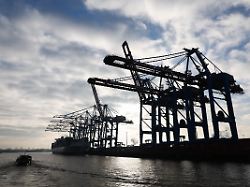Good start into the New Year
Global trade is increasing noticeably
2/7/2023 11:54 am
Economists are optimistic. As the Kiel Institute for the World Economy notes, foreign trade made “big leaps” in January. “This is a particular boost for European and German foreign trade,” it says. And there is one more positive news.
A glimmer of hope for Germany, the European export champion threatened by recession: According to the Kiel Institute for the World Economy (IfW), world trade is picking up speed at the beginning of the year and could be on the verge of a longer upswing. The trade indicator for January signals growth in world trade of 2.1 percent compared to the previous month, as the researchers announced. “This is a particular boost for European and German foreign trade,” it said.
Accordingly, the barometer for German foreign trade is clearly pointing upwards for both exports (plus 2.1 percent) and imports (plus 2.6 percent). The EU is benefiting even more from the global momentum with a strong increase in exports (plus 3.0 percent) and imports (plus 3.2 percent). The two largest economies in the world, the USA and China, are also showing an increase in exports, but a minus in imports.
“January brought great leaps in German and European foreign trade and thus a good start to the new year,” said IfW expert Timo Hoffmann. “Germany is obviously benefiting from high demand for German products abroad, which is also reflected in the high order backlog in industry.” China’s trade, on the other hand, still has room for improvement. Weak imports there signaled subdued domestic demand.
Significantly fewer ship traffic jams
Easing congestion on the oceans fits in with the positive start to the year. Only eight percent of all goods shipped worldwide are currently stuck, as determined by the IfW. At the height of the delivery bottlenecks, it was almost 14 percent. “For the first time since the outbreak of the corona pandemic and since the container ship network got out of step, ship congestion has reached a level that was reached before the pandemic and that does not have to be classified as a disruption,” said Hoffmann.
The main reason for the reduction in congestion is probably that fewer goods were transported by sea worldwide. “On the one hand, this can be explained by the fact that freight forwarders have probably organized alternative transport routes by rail or road in the course of ship jams and exploded freight rates and are now maintaining them,” said the IfW expert.
In addition, China’s weak demand has consequences. “The volume of freight in the Red Sea – the most important sea trade route between Europe and China – is noticeably below the normal volume before the outbreak of the Corona crisis.” Responsible for the gap is mainly less freight from Europe to China. Free freight capacities, a container ship network on the way to equilibrium and catch-up potential in China gave hope for a longer upswing in international trade.
